Jharkhand is one of the most ethnically rich and culturally vibrant states in India. The folk dances of Jharkhand are very lively, colourful, and vibr
Jharkhand is one of the most ethnically rich and culturally vibrant states in India. The folk dances of Jharkhand are very lively, colourful, and vibrant. Various songs are dedicated to not only festivals and social gatherings but to mark some important agricultural events as well. These dances depict the identity and tradition of the tribes residing in these parts. Not only are these folk dances a way of expressing joys but it is a way for the local people to come together in peace and harmony and maintain their ties among the tribal community. Here are the famous folk dances of Jharkhand.
List of the 14 Folk Dances of Jharkhand
1. Chhau Dance
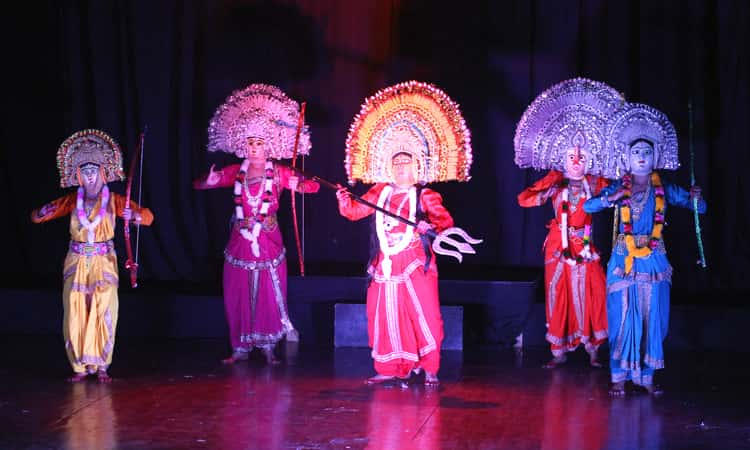
Finding its roots in Jharkhand, the Chhau Dance is included in the UNESCO heritage dance forms. The Chhau Dance travelled through the neighbouring states of Bihar and Odisha and became an indispensable part of their folk dance culture as well. The dance is predominantly done by male performers with the prop masks being used in some cases. The dance represents the combination of semi-classical dance form with martial arts style. The dance steps range from celebrating martial arts, to acrobatic and athletic performances. The stories enacted through the Chhau Dance can include Hindu epics such as Ramayana and Mahabharat. What started off as a male dance form has now evolved enough to include women in groups as well.
2. Paika Dance
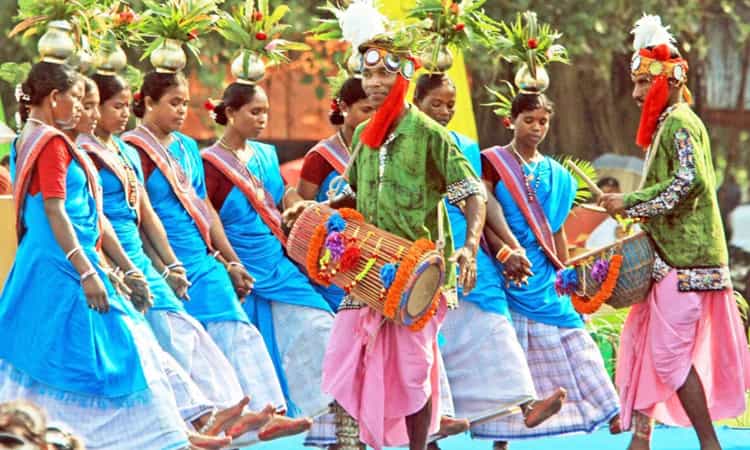
Jharkhand is home to many tribal communities coexisting in complete peace and harmony with each other. The Paika is a folk dance of one of these communities. It is generally performed as a way to welcome special or important guests during some religious procession or special occasions. The dance is depicted more in the form of a battle art where the dancing artiste clutches on a dhal or shield in one hand and a two-edged sword in the other. The inspiration for the dance name came from the incredibly colourful and brightly colored clothing they wear while performing the dance. The sound of Payal and Ghungroo while doing the dance creates a very peaceful environment.
3. Khadia Dance
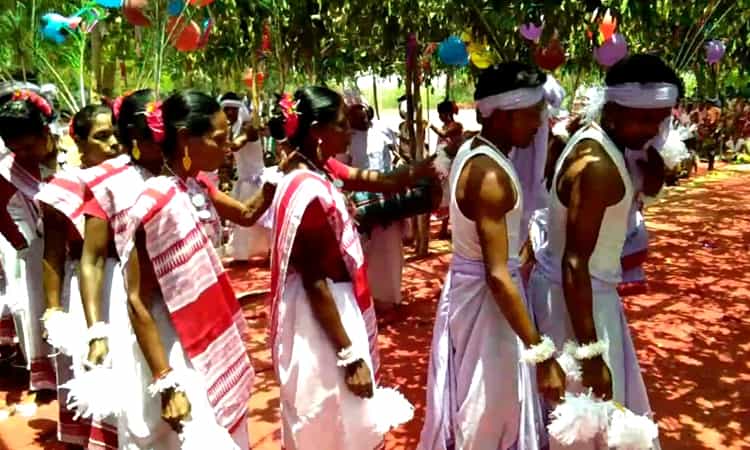
Finding its roots in the Khadia tribal community of Jharkhand and a major part of the agneya family, the Khadias are very distinct from the rest of the tribal community in Jharkhand, culturally speaking. The Khadia Dance takes place during the important agricultural events and weather changes that take place over the year. The women take part in this dance by holding each other’s hands and standing in a row. This goes on while the make dance carry on with their dance separately. The dance is accompanied with Mandar, Dhol, Nagara and other such folk instruments.
4. Kadsa Dance
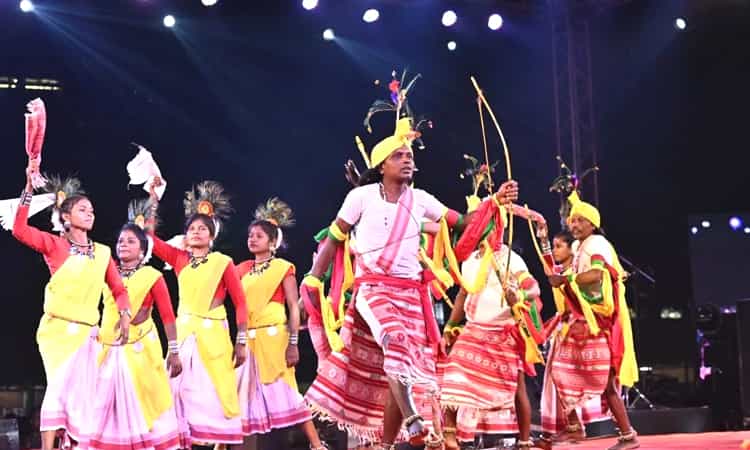
Urao is another one of the most important and major tribes residing in Jharkhand. They are known for being incredibly musical and entertaining by nature. The dance is celebrated on any special occasion over the year. Unlike many other folk dances, the Khandsa Dance is not accompanied with any musical instruments but in fact it is mainly accompanied with folk songs sung by the locals. The dance is done by men as well as women standing and swaying around in circles and also including some limping-like motions. The footsteps performed during the dance is more interesting than anything else.
5. Nagpuri Dance
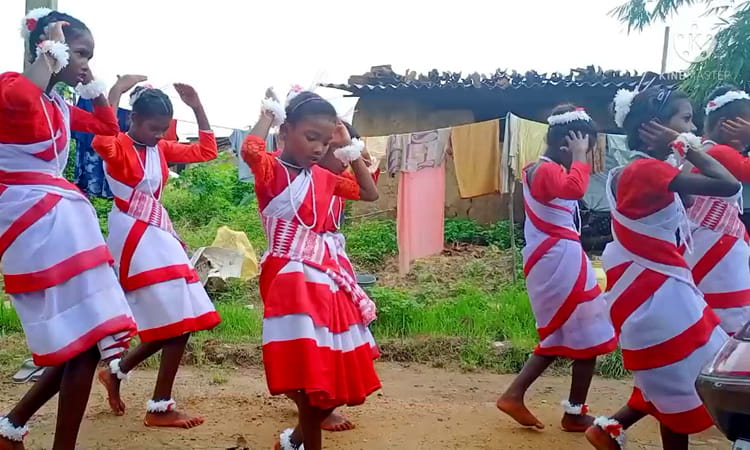
Most of the folk dances of Jharkhand are primitive and can easily date back to the ancient ages. One such primitive folk dance form is the Nagpuri Dance of Jharkhand. It is a very interesting dance form that starts off slowly and gains a lot of momentum as the music proceeds. Although its history dates back to centuries ago, its steps and motions can be easily included as being one of the modern dance forms as well. The mixed nature of this dance form makes it a fun experience to witness especially during the time of some fair and festivals.
6. Birhor Dance
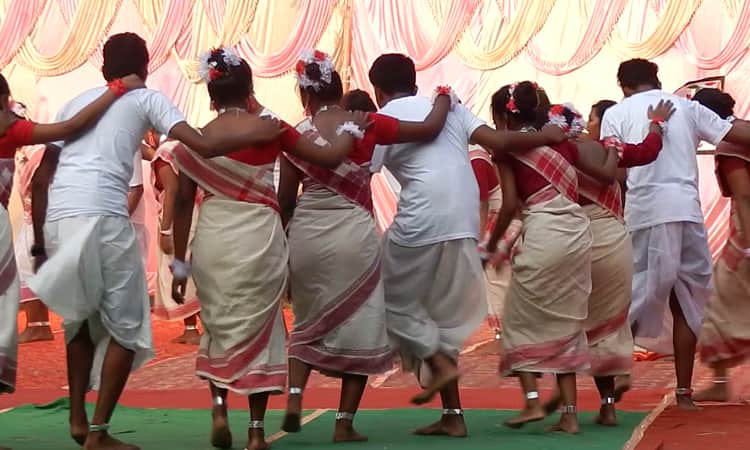
Borohr Dance originated from the Birohr community of people residing in the forests of Jharkhand. The term Birohr itself translates into jungle people literally and are deeply bounded by the earth, nature and its resources. The Birohr Folk Dance can be seen during the Diwali festival as well as during special occasions such as marriages etc. the community is involved mainly in performing this dance alongside the drumming and traditional musical performances. They stand in rows, while resting their hands on each other’s shoulders and moving in sleek, elegant and gently swaying motion.
7. Mundari Dance
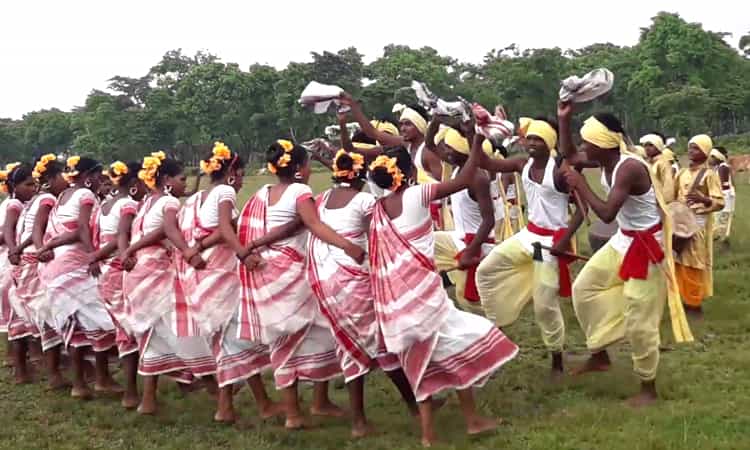
The Mundari Dance of Jharkhand can be traced back to the Munda tribal community of Jharkhand. This munda community has their own identity which is extremely distinct from the rest of the community. The dance is performed during the peak harvest season and during various festivals and fairs and are accompanied with folk musical instruments such as Bansi, Nagada and Madal. The songs sung along with the dance are Susun and Durang. The dance is undoubtedly one of the most well-preserved part of the Munda culture.
8. Santhali Dance
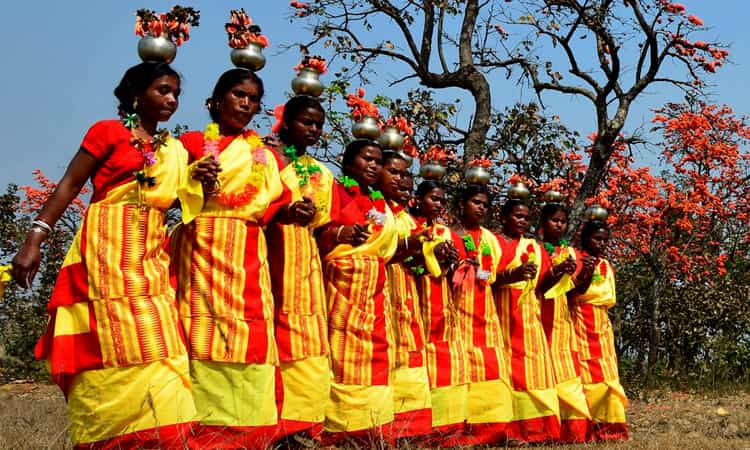
The origin of Santhal Dance can be easily traced to the tribal communities of states of West Bengal and Jharkhand. The Santhal tribe is rich in its cultural heritage and lineage that has kept the people together in complete unity and harmony through the years. The dance is all about displaying cheerfulness and vibrancy of the people. The dance is traditionally performed by men as well as women and often covers various issues of the society pertaining to gender and land rights. Accompanied with folk music played by traditional instruments and folk songs. The locals can be seen performing the dance, especially during the spring harvest season as they celebrate the glory of nature.
9. Hunta Dance
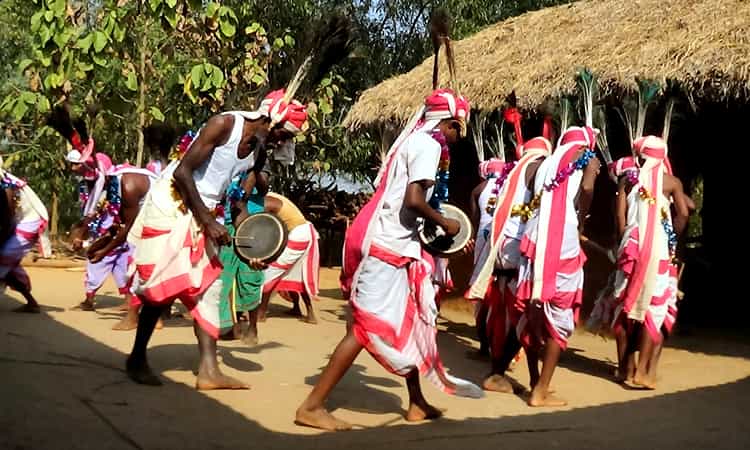
The santhals are happy people who love celebrating everything and every special occasion. One such dance of celebration is known as Hunta. Residing in the Chota Nagpur Plateau region of east India, the Hunta Dance refers to the hunting dance of the community. The dance elaborately depicts the act of preparing for the hunt using bows, arrows, the act of stalking the next animal to kill and then finally executing it. The dance involves acts of miming, slow stepping and carefully choreographed foot movements and measured steps. Dating back to the ancient ages, this tribal dance is a great way of celebrating special occasions and events.
10. Karam Dance
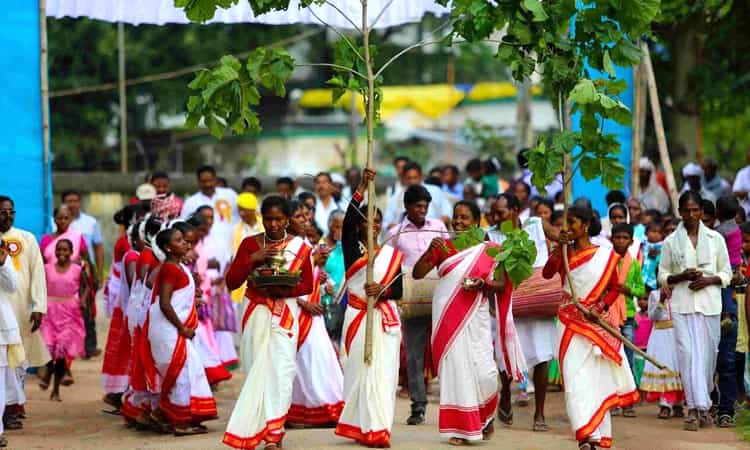
Karam or the karma dance of central and eastern India is performed during the annual festivities of the holy karma puja. The karma festival is a popular and annual celebration of autumn harvest. The festival starts off on the 11th day of the bright fortnight month of Bhadrab. Other than Jharkhand, the dance is also performed by tribes residing in the state of Chhattisgarh, Madhya Pradesh, Odisha and even West Bengal. The dance is also a way of worshipping the god of fate who is referred to as the Karam Devta who is considered as the cause of good and bad fortune.
11. Barao Dance
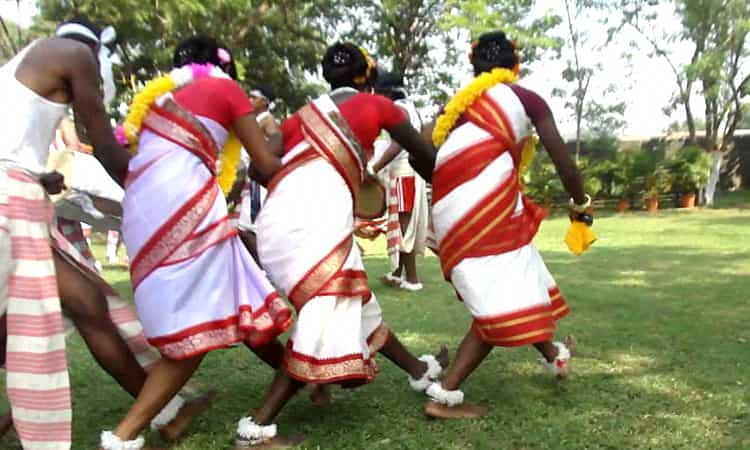
The Bharao Dance is rich in musical composition and variety. The dance is well preserved by the people of the Oraon community who are mainly concentrated in the Hazaribagh Gumla region of Jharkhand. The region is dotted with thick forest cover and greenery where the tribe resides. Both men, as well as women, participate in the dance performance that takes place during the monsoon months of Baisakh lasting from the months of April to May. Along with the dance, the village groups also take part in Jatra or local folk theatre performances. Through the dance, the community offers prayers to mother earth and thank her for a plentiful monsoon followed by a good harvest season.
12. Jhenna Jhumur Dance
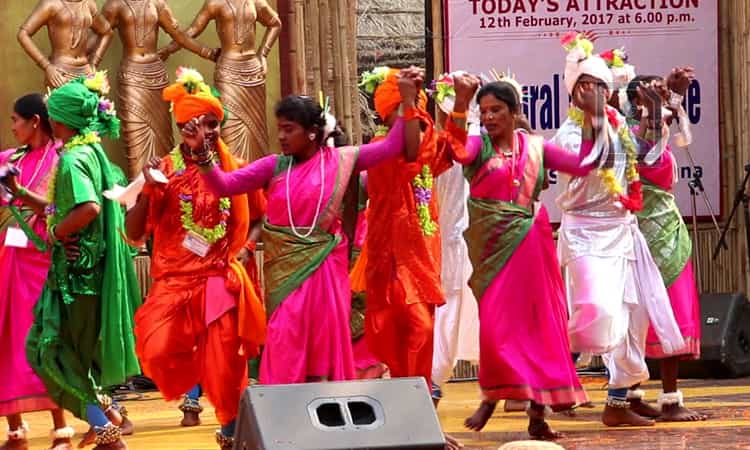
There are many dances whose roots lay in the santhalis and traditional Nagpuri tribal community residing in the eastern part of the subcontinent. The Jhenana Jhumur Dance is predominantly focussed on groups of women performing the dance wearing their traditional clothing and jewellery. Primarily performed during the harvest celebration season, this dance is a great way for the agricultural people to offer their thankfulness to the lord and the powers of nature.
13. Domkach Dance
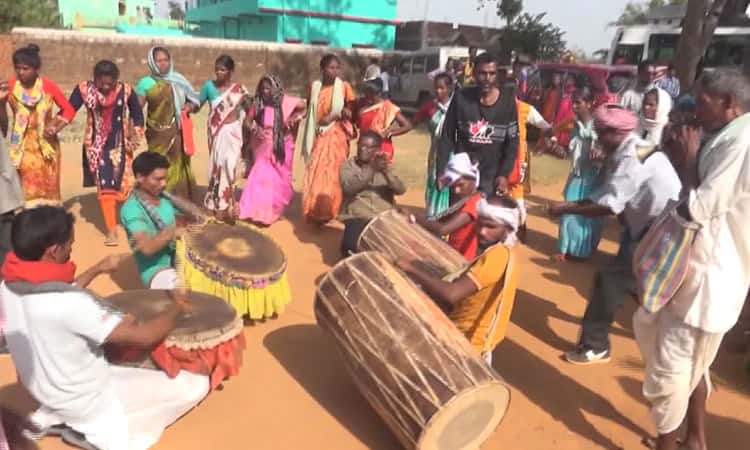
The Domkach Dance is a type of folk traditional dance form of Bihar and Jharkhand. In Bihar this dance is mainly performed in the Mithila and Bhojpur regions of the state whereas in Jharkhand it is included in the Nagpuri folk dance form. The dance is performed mainly during marriage and wedding occasions by the groom’s as well as the bridegroom’s family. The dancers form a semicircle and hold each other’s waist while singing satirical songs of joyousness. Depending on the region, there are different types of Domkach Dances.
14. Ghoda Naach Dance
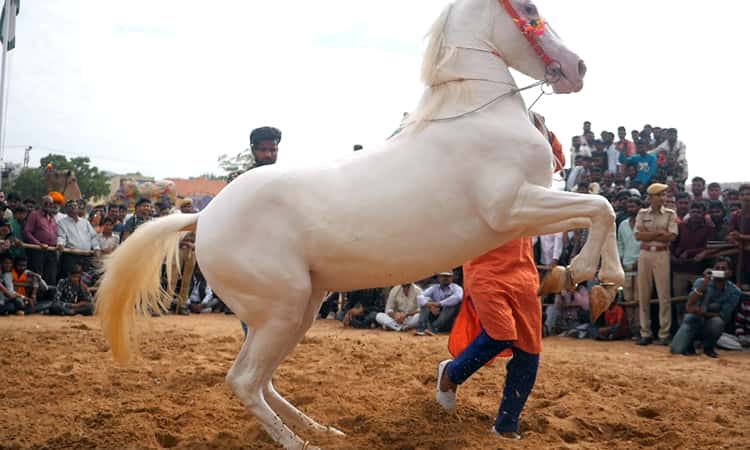
The Ghoda Naach or the horse dance is one of the famous Indian folk dances that has their own variation throughout the country. The dance is mainly performed by the local men folk of the community during special occasions and festivities. The prop used in the dance is a dummy puppet horse that the male dancers tie around their waist and dance to the rhythmic beats of the folk traditional music.
Frequently Asked Questions (FAQs)
Q. Suggest Places To Visit In Jharkhand?
Ans. Dassam Falls, Baba Baidyanath Temple, Patratu Valley, Jubilee Park etc. are some of the must-visit places to visit in Jharkhand.
Q. What Are The Famous Foods Of Jharkhand?
Ans. Arsa Roti, Malpua, Chilka Roti, Mutton Curry, Fish Fry, Tilkut etc. are some of the popular dishes of Jharkhand.
Q. When Is The Best Time To Visit Deoghar?
Ans. October to March is the best time to visit Deoghar.
Q. Which Is The Most Famous Festival In Jharkhand?
Ans. Sarhul Festival, Karma Puja, Saraswati Puja, Vishwakarma Puja, Durga Puja, Christmas etc. are some of the most famous festivals in Jharkhand.
Q. How Many Tribal Communities Reside In Jharkhand?
Ans. Jharkhand is home to about 32 different tribal communities.


 Call
Call WhatsApp
WhatsApp Enquiry
Enquiry
COMMENTS